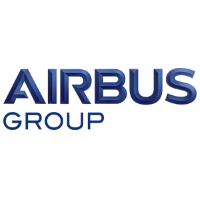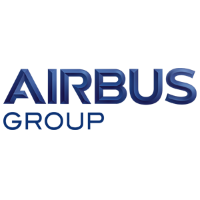
Airbus SE
XETRA:AIR

Airbus SE





In the competitive skies of the global aerospace industry, Airbus SE stands as a formidable leader, weaving together innovation, efficiency, and strategic vision. Originating from a consortium of several European aerospace entities in 1970, it was created to challenge the dominance of American manufacturers in the commercial aircraft market. Airbus quickly became synonymous with technological advancement—it was the first company to introduce digital fly-by-wire control systems in commercial aircraft, a leap that has defined modern aviation. Over the years, the company’s portfolio has expanded significantly, ranging from commercial airliners like the A320 and A350 families to military aircraft and helicopters. The diverse offerings have cemented its position as a pivotal player in shaping aviation technology and expanding global connectivity.
The financial heartbeat of Airbus is driven by its Commercial Aircraft division, which constitutes the bulk of its revenue. With airlines and lessors around the globe vying for Airbus’s fuel-efficient aeroplanes, the company has successfully capitalized on the burgeoning demand for air travel. By maintaining a strong order book, Airbus ensures a steady revenue stream, manifesting from both aircraft sales and a suite of after-sales services, including maintenance and spare parts provision. Complementing this revenue channel is Airbus’s Defense and Space division, offering military aircraft, satellite systems, and related services. In addition, its Helicopters division caters to a wide array of civilian and military operations worldwide. Through a strategic blend of continuous innovation, timely delivery, and regulatory compliance, Airbus adeptly navigates the complex landscape of the aerospace market, generating sustained profitability and driving shareholder value.
Earnings Calls
In Q1 2025, Airbus generated EUR 13.5 billion in revenue, up 6% year-on-year, bolstered by robust service volumes. Aircraft deliveries reached 136, but supply chain issues, particularly with engines, led to 17 aircraft awaiting parts. EBIT adjusted remained stable at EUR 0.6 billion. The company anticipates 820 commercial aircraft deliveries for the full year, with an adjusted EBIT of EUR 7 billion and free cash flow of EUR 4.5 billion. Despite geopolitical uncertainties affecting tariffs, Airbus maintains a solid backlog of 8,726 aircraft, reflecting a positive long-term outlook in defense and commercial segments, signaling resilience amidst ongoing challenges.
Management

Dr. Thomas Toepfer is a notable executive with an extensive background in finance and leadership roles across various industries. He joined Airbus SE as the Chief Financial Officer (CFO) in 2023. Before his role at Airbus, Dr. Toepfer was the CFO and member of the Executive Board at Covestro, a leading polymer company, where he played a crucial role in the company’s financial strategies and performance. He holds a Ph.D. in Business Administration and Economics, demonstrating his strong academic background, and has accumulated significant experience in key leadership positions throughout his career. His expertise includes financial management, strategic planning, and organizational restructuring, which have been instrumental in driving growth and efficiency in multinational corporations. Dr. Toepfer’s career began in various finance-related roles, including positions at companies like Bayer and KION Group, where he honed his skills in financial oversight and strategic corporate development. At Airbus, he is responsible for overseeing the financial operations and ensuring the company's fiscal health, contributing to its global strategic objectives. His leadership is marked by a focus on innovation, sustainability, and digital transformation, aligning with Airbus's goals of advancing in these critical areas. His experience and strategic acumen continue to make a significant impact on Airbus's operational and financial outcomes.

Sabine Klauke is the Chief Technology Officer (CTO) at Airbus SE, a leading aerospace corporation. In her role as CTO, she is responsible for guiding the company's technology and innovation strategies, focusing on sustainable aerospace technologies. Klauke's expertise plays a critical part in advancing Airbus’s objectives in areas such as decarbonizing the industry and developing zero-emission aircraft. Before becoming CTO, Klauke held various significant positions within Airbus, showcasing her leadership and engineering prowess. She has a strong academic background, including a degree in Mechanical Engineering and a Ph.D. in Engineering, both of which have provided her with a solid foundation for her roles in the aerospace sector. Throughout her career at Airbus, Klauke has demonstrated a commitment to fostering technological advancements and has been involved in a variety of initiatives to promote innovation and environmental sustainability in aviation. Her leadership continues to be instrumental in driving Airbus's success and its contributions to the future of the aerospace industry.

Catherine Jestin is an executive at Airbus SE, serving as the Executive Vice President of Digital and Information Management. In this role, she is responsible for driving the digital transformation across the company to enhance Airbus’s industrial operations, products, and services. Jestin focuses on leveraging digital tools, data analytics, and information management to foster innovation and improve efficiency within Airbus. Before joining Airbus, Catherine Jestin held significant positions in various industries, specializing in digital strategies and information technology. Her leadership is characterized by a commitment to empowering teams and creating value through technology-driven solutions. Her experience in digital transformation and IT makes her a pivotal leader in steering Airbus through its technological evolution.

John Harrison served as the General Counsel of Airbus SE. In this role, he was responsible for overseeing the company's legal affairs and compliance programs. Harrison joined Airbus in June 2015, bringing with him extensive experience in managing legal and compliance matters on a global scale. Before his tenure at Airbus, he held key legal positions in multinational companies and was known for his strategic approach to navigating complex legal landscapes. His leadership contributed significantly to Airbus's efforts in maintaining robust legal frameworks and ensuring regulatory compliance.

Julie Kitcher is a prominent executive at Airbus SE, where she has held key leadership roles. As the Executive Vice President of Communications and Corporate Affairs, she has been a vital part of Airbus's management team. She is responsible for the company's global communication strategies, ensuring that Airbus maintains a strong and positive reputation worldwide. Julie joined Airbus in 2000 and has since built an extensive career within the company, gaining significant experience across various roles before stepping into her executive position. Her expertise encompasses investor relations, financial communication, and media relations, reflecting her comprehensive understanding of both the aerospace industry and corporate communication. In her current role, Julie is also responsible for corporate affairs, which includes overseeing public policy and company-wide initiatives related to sustainability and corporate social responsibility. Her leadership has been instrumental in advancing Airbus’s commitment to transparency and stakeholder engagement. Julie Kitcher is widely recognized for her strategic vision and her ability to effectively communicate complex business strategies to diverse audiences. Her contributions have significantly shaped Airbus’s public image and its approach to global communication challenges.

Thierry Baril is a prominent executive known for his role at Airbus SE, where he serves as the Chief Human Resources Officer (CHRO). He joined Airbus in 2007 and has played a crucial role in managing and developing the company's workforce across various global locations. Baril has a strong background in human resources and management, bringing significant experience to Airbus. Before joining Airbus, he held several key HR positions, including at Eurocopter, which is also part of the Airbus Group. His leadership in HR has been instrumental in fostering a culture of innovation and efficiency within the company. He holds a Master’s degree in Business Administration and has cultivated a reputation for his strategic approach to human resource management. His career is distinguished by a focus on talent development, organizational transformation, and enhancing employee engagement, all of which have been critical to supporting Airbus's growth and competitiveness in the aerospace industry. Baril’s work supports Airbus's goal of being a top employer in the aerospace sector, attracting and retaining top talent worldwide.

Didier Lux is a prominent figure in the aerospace industry, known for his significant contributions during his time with Airbus SE. He held various leadership positions, primarily focused on customer services, helping to forge vital relationships between Airbus and its clients. With a strong background in engineering and customer support, Lux was instrumental in enhancing Airbus's service capabilities and ensuring that the company met the evolving needs of its airline customers. His leadership style and strategic vision helped Airbus maintain a competitive edge in the global aerospace market, fostering innovation and improving customer satisfaction. His work ensured that Airbus's commitment to quality and reliability translated into strong, lasting partnerships across the aviation sector.
Geneviève Laurens-Chassagne is a notable executive known for her role within Airbus SE. She has held significant positions in the company, contributing to its financial and strategic direction. As the Head of Investor Relations at Airbus, Laurens-Chassagne played a crucial role in managing the company's relationships with investors and the financial community, ensuring clear communication about Airbus's financial health, strategic initiatives, and market outlook. Her expertise in finance and investor relations has been pivotal in fostering investor confidence and supporting Airbus's growth objectives. Laurens-Chassagne's career reflects her strong background in finance and corporate communications, making her a key figure in aligning investor interests with the company's goals.

Philippe Mhun is a senior executive at Airbus SE, the European multinational aerospace corporation. He serves as the Chief Programs & Services Officer, a position that plays a crucial role in overseeing the company’s commercial aircraft programs and services. Mhun is responsible for managing the lifecycle of Airbus's products, ensuring they meet customer expectations and maintaining efficient service operations. His career at Airbus has been marked by extensive experience in both engineering and customer service, which equips him with a deep understanding of the technical and commercial aspects of aerospace operations. Before his current role, Mhun held various significant positions within Airbus, contributing to the company's strategic focus on innovation and customer satisfaction. Philippe Mhun's expertise in engineering and program management has been instrumental in navigating the complexities of aircraft production and service delivery. He is known for his leadership skills and his ability to implement strategies that enhance operational efficiency and foster customer loyalty. His contributions are vital to Airbus's mission of maintaining its position as a leader in the aerospace industry.

Johan Pelissier is a notable executive at Airbus SE, particularly known for his role within Airbus Defence and Space. With a career spanning over two decades in the aerospace and defense industry, Pelissier has held various leadership positions that have significantly contributed to the company's operations and strategic direction. As an influential leader in Airbus's global team, he has been involved in the advancement of satellite communications, data services, and innovative aerospace solutions. His educational background in engineering and business management has supported his expertise in navigating complex projects and fostering partnerships across the aerospace sector. Pelissier is recognized for his leadership in promoting cutting-edge technology solutions and driving the development of sustainable and efficient aerospace systems. Throughout his career at Airbus, he has demonstrated an ability to adapt to industry changes and steer the company towards new growth opportunities in the competitive defense and space markets.
















































 You don't have any saved screeners yet
You don't have any saved screeners yet

Ladies and gentlemen, thank you for standing by. Welcome to the Airbus Q1 2025 Results Release Conference Call. I am Sharon, the operator for this conference. [Operator Instructions] The conference is being recorded. [Operator Instructions]
At this time, I would like to turn the conference over to your hosts, Guillaume Faury, Thomas Toepfer, Helene Le Gorgeu, please go ahead.
Thank you, Sharon, and good evening, ladies and gentlemen. This is the Airbus Q1 2025 Results Release Conference Call. Guillaume Faury, our CEO; and Thomas Toepfer, our CFO, will be presenting our results and answering your questions.
This call is planned to last around 1 hour. This includes Q&A, which we will conduct after the presentation. This call is also webcast. It can be accessed via our home page by clicking on the dedicated banner. Playback of this call will be accessible on our website, but there is no dedicated phone replay service. The supporting information package was published on our website earlier today. It includes the slides, which we will now take you through as well as the financial statements.
Throughout this call, we will be making forward-looking statements. I invite you to refer to our safe harbor statement that appears in the presentation slides, which applies to this call as well. Please read it carefully.
And now over to you, Guillaume.
Thank you, Helene, and hello, ladies and gentlemen. Thank you for joining us today, as said earlier, for the Q1 2025 results call. And we are here in Amsterdam with Thomas to run you through our results.
We continue to operate in a fast-changing operating environment, particularly when it comes to global trade uncertainty, which is adding complexity and the geopolitical shift shaping European defense. So namely tariffs on the one hand and the European defense situation on the other one.
The evolving global tariff environment is uncertain in terms of implementation, scope and duration. As of today, our direct financial exposure lies mainly with the cost increase of subassemblies imported into our final assembly lines located in the U.S. and China, with the caveat we might make later that things keep changing on the Chinese front. As we progress on our assessments, we're identifying the means to adapt and mitigate the impact by leveraging our industrial setup as well as our strong and diversified backlog.
Moving to defense. We support the recent approach to make the European defense industry stronger and more competitive. This step change is calling for a significant spending increase, notably to reduce the capability gaps and secure European strategic autonomy. We are engaging with governments to address the European priorities with our 2 divisions involved in defense matters, namely Airbus Defence and Space and Airbus Helicopters.
In that context, the Q1 results show the progress we are making on our priorities across the business. In particular, we continue to move forward on our ramp-up, and we delivered 136 aircraft in Q1 this year. In light of the specific supply chain issues highlighted at the full year, we continue to expect the delivery profile to be back-end loaded.
Our EBIT adjusted stood at EUR 0.6 billion, reflecting in particular the commercial aircraft deliveries as well as the strong performance in Defence and Space. Our free cash flow before customer financing was negative EUR 0.3 billion, reflecting the planned inventory buildup and the commercial momentum across businesses.
Our full year 2025 guidance remains unchanged. It excludes tariffs, and we will come back to this later. We will also provide more color on the signed definitive agreement with Spirit AeroSystems, which we just announced. We are pleased to have reached this milestone, which contributes to securing stability for our ramp-up.
Let's now look at our commercial environment, starting with commercial aircraft. In Q1, global air traffic continued to grow, especially with an acceleration of international passenger traffic. Of course, we are closely monitoring how tariffs and the current macro environment could potentially impact air traffic and our customers. Our robust and diversified backlog would support the company's resilience in case these conditions were to last and/or to deteriorate.
During this quarter, we booked 280 gross orders. And looking at the narrow-bodies, we booked 233 gross orders. On widebodies, we recorded 47 gross orders, underpinning the continued momentum for our widebody family and bringing the backlog to a record level. Net orders amounted to 204 aircraft, after 76 cancellations, which were largely anticipated and embedded in our backlog valuation as of year-end 2025 -- 2024. Our backlog in units increased to 8,726 aircraft at the end of March 2025.
Moving on to Helicopters. In Q1, we booked 100 net orders compared to 63 in Q1 last year, and this 100 were well spread across the portfolio. We are once again very pleased with the trust placed by our customers in our products and services, as seen at VERTICON 2025, which is the former HELI-EXPO in the U.S. During this year's event, we announced 63 firm orders and 55 commitments from customers worldwide from a variety of our platforms. And during the show, we also introduced the H140, our newest multi-mission helicopter, which received its first orders and commitments at the show. This H140 sets a new standard in the light twin-engined category for performance, cost effectiveness and passenger and crew comfort. It features a larger cabin space than the previous version with an optimized layout and a wide range of innovations. The entry into service is planned for 2028 for the Emergency Medical Services segment for the entry into service. Other variants coming later. We continue to see positive momentum in both the civil and military markets for Helicopters, and we remain focused on securing new business opportunities in both our home countries and on export markets.
And before moving to Defence and Space, I'd like to mention that the H160 received certification from the Civil Aviation Administration of China, the CAAC, earlier this month, allowing deliveries to begin in China.
Finally, in Defence and Space, we started the year with a strong order intake of EUR 2.6 billion for the Q1. We continue to see a good momentum across the different businesses of the division, notably on Air Power in both platforms and services. During the quarter, we also announced a contract with the so-called Direction générale de l'armement, the DGA, the French DGA, for a new definition study of the French Navy's future maritime patrol aircraft, the MPA. This program is based on the A321XLR. This contract aims at preparing for the development and production launch of the program at the end of 2026.
On Connected Intelligence, we've been awarded the stage 3 contracts for the IP network of the Naval Force, also by the Direction générale de l'armement, to upgrade and maintain the network and communication systems of the French Navy. We also signed a contract with Rheinmetall and blackned GmbH to support the German Bundeswehr's digitalization of land-based operations.
And with regard to space, we've been awarded the overall contract to design and build 2 Synthetic Aperture Radar satellites for the UK Ministry of Defence, providing high-resolution, all-weather, day-and-night Intelligence, Surveillance and Reconnaissance, so-called ISR capabilities, to the British and allied defense forces. Last but not least, we are pleased with the success of Ariane 6's first commercial mission, which placed in orbit the Airbus-built CSO-3, an earth observation satellite for the French Armed Forces. The priority is now to secure the Ariane 6 ramp-up.
And with this, now I will hand over to Thomas that will take you through our financials.
Thank you very much, Guillaume, and hello, ladies and gentlemen. Thank you for joining us on this call. I'm now on Page 6 of the presentation, and I would like to take you through our financial performance.
Now as you can see on the slide, our Q1 2025 revenues increased to EUR 13.5 billion, which is up 6% year-on-year, mainly reflecting the higher contribution from our divisions, the stronger services volumes across our businesses and a more favorable FX environment.
And on the right-hand side, you see our R&D expenses stood at EUR 0.7 billion in Q1 '25, just slightly lower compared to Q1 2024. And consistent with what we have said during the full year 2024 disclosure, the LEAD! initiative is reflected in the lower Q1 2025 R&D expenses. And I would just like to remind you that our R&D expenses are expected to only marginally increase in 2025 with a back-end loaded profile.
So let's turn the page to Page 7 and onto EBIT adjusted. Our Q1 2025 EBIT adjusted stood at EUR 0.6 billion, stable compared to Q1 2024. And the slightly lower volume of commercial aircraft deliveries is, of course, reflected in our profitability, especially in a situation of excess staffing. And here, I would like to remind you that, of course, we continue to hire in order to support our ramp-up, however, at a somewhat lower pace than in 2024. And the result also reflects a more favorable hedge rate as well as a stronger performance in Defence and Space.
Now coming to the EBIT adjustments, which were negative in Q1 2025, and you find them on the upper right-hand side of the page. And as you can see, they included negative EUR 13 million impact from the dollar working capital mismatch and balance sheet revaluation, a negative EUR 105 million related to the Airbus Defence and Space workforce adaptation plan. And while we are still finalizing the plan, the progress made in redeployment measures and dialogue with the social partners allowed us to record a restructuring provision. And finally, it includes negative EUR 33 million of other costs, including compliance and also M&A.
And that then takes us to our Q1 2025 EBIT reported, which is at EUR 0.5 billion positive. And then just to round it up, as you can see, our financial results were EUR 621 million and mainly reflects the revaluation of certain equity investments, partially offset by the evolution of the U.S. dollar and the revaluation of financial instruments.
The tax rate on the core business continues to be at around 27%. However, the effective tax rate is 32%, including the tax effect on the revaluation of certain equity investments as well as a net deferred tax asset impairment. And we still expect the French surtax to result in an impact of around EUR 300 million in 2025, both in terms of P&L and cash. And in Q1 2025, we recorded the part which is related to the year 2024 as well as the part corresponding to the first quarter of 2025. Now with all of that, the resulting net income is EUR 0.8 billion, with earnings per share reported of EUR 1.01 per share, and our Q1 2025 EPS adjusted stood at EUR 0.67 based on an average of 787 million shares.
Now with that, onto our U.S. dollar exposure coverage, which you find on Page 8. In Q1 2025, USD 4 billion of forwards matured with the associated EBIT impact and euro conversions realized at a blended rate of $1.19 versus $1.23 in Q1 2024. And in Q1 2025, we also implemented $3.3 billion of new coverage at a blended rate of $1.10. So as a result, our total U.S. dollar coverage portfolio in U.S. dollar stands at USD 82.1 billion with an average blended rate of $1.21, as compared to $82.8 billion at $1.21 at the end of 2024. Now as mentioned in the full year 2024 disclosure, we have adjusted our portfolio this quarter by implementing some rollovers to reflect the delivery target and delivery profile for 2025 which, as you know, we expect to be back-end loaded.
Let us turn the page to Page 9 and talk about the cash evolution. So first of all, onto a more detailed look at the free cash flow. As you can see, our free cash flow before customer financing was negative EUR 0.3 billion in Q1. And this mainly reflects the level of profitability which, of course, turns into cash as well as the planned inventory buildup to support our ramp-up across our businesses. But then on the positive side, it includes as well a favorable phasing of receipts and payments also from the strong commercial momentum across all our businesses, resulting in a very strong cash collection.
The A400M was broadly neutral from a cash flow perspective. Our Q1 2025 CapEx was negative EUR 0.6 billion. And to support our ramp-up, we expect our CapEx to slightly increase in 2025. So with that, free cash flow was negative EUR 0.3 billion with nearly no impact from customer financing. And having said that, the aircraft financing environment remains strong and competitive, so we expect sufficient liquidity to finance our 2025 delivery, and we keep on closely monitoring the possible impact of tariffs. Our net cash position stood at EUR 11 billion as of the end of March, and our liquidity remains at around EUR 35 billion.
And with that, I would like to hand it back to Guillaume.
It's a pleasure, Thomas. And let's look at the different businesses, starting with Commercial Aircraft. In Q1, in 2025, we delivered 136 aircraft to 49 customers.
Looking at the situation by family. On narrow-bodies, we delivered 17 A220 and 106 A320 family aircraft, of which 65 are A321s, representing 61% of deliveries for the family. On A320, we continue to ramp up towards a rate of 75 aircraft per month in 2027.
We delivered 13 widebodies, of which 4 A330s and 9 A350s. And on the A330, we are now stabilizing at a monthly production rate of around 4. So-called specific supply chain challenges, notably with Spirit AeroSystems, are currently putting pressure on the ramp-up of the A350 and the A220. On the A350, we continue to target the rate of 12 in 2028. And on the A220, we continue towards the monthly production rate of 14 aircraft in 2026.
In a nutshell, we delivered in line with our plan and consistently with the specific supply chain issues highlighted at the full year. These issues have not changed, notably the persisting tensions on engines for narrow-body for A320 with CFM, resulting in 17 gliders, so aircraft finished but without engines, so-called gliders, 17 of them at the end of the first quarter. This situation will continue until the summer with a likely increased number of gliders due to missing CFM engines. This will result in a rather soft delivery number for H1 before it normalizes in the second half of the year to support the full year guidance.
Now let's look at the financials for our Commercial Aircraft business. Revenues increased by 4% year-on-year, mainly reflecting the more favorable foreign exchange environment, partially offset by a slightly lower number of deliveries. EBIT adjusted was stable at EUR 0.5 billion in Q1 2025 with a decrease of deliveries and the excess workforce being offset by a favorable hedge rate and lower R&D expenses.
Looking at Helicopters on the Page 12. In Q1 this year, we delivered 51 helicopters, broadly stable as compared to the first quarter of last year. Revenues increased around 10% to EUR 1.6 billion, reflecting a solid performance from programs and services growth. As a result, EBIT adjusted stood at EUR 78 million.
And let's complete our review with Defence and Space. Revenues increased 11% year-on-year to EUR 2.7 billion, driven by higher volumes across all business lines. EBIT adjusted stood at EUR 77 million, supported by higher volumes and better profitability, mainly on the Air Power services and Connected Intelligence, CI.
On the A400M program, constructive discussions continue with the Launch Nations and OCCAR on the production plan. In light of uncertainties regarding the level of aircraft orders, Airbus continues to assess the potential impact on the program's manufacturing activities, risks on the qualification of technical capabilities, and associated costs remain stable.
And before moving to the 2025 guidance, Thomas will give you more color on the definitive agreement we just entered into with Spirit AeroSystems.
Yes, with pleasure. Let me just highlight the progress that we have made on the acquisition of certain Spirit AeroSystems activities. Airbus has now entered into a definitive agreement for the acquisition of these work packages, which are key for our Commercial Aircraft ramp-up.
And as per the initial term sheet, the transaction includes the production of the A350 fuselage sections in Kinston, North Carolina in the United States, and in Saint-Nazaire, France. It includes the A321 and A220 components in Casablanca, Morocco. It includes the A220 wings in Belfast, Northern Ireland as well as the A220 pylons in Wichita in the United States.
Now with the definitive agreement, it also includes the production of the A220 mid-fuselage in Belfast, Northern Ireland, unless Spirit AeroSystems identifies a suitable buyer for the part of the site where these activities are located. And Airbus will also acquire the production of wing components for the A320 and A350 in Prestwick, Scotland.
When it comes to Subang in Malaysia, Spirit AeroSystems intends to sell this site to a mutually agreed third-party owner. The compensation amount has been adjusted to reflect this revised transaction parameter in line with the provisions of the binding term sheet agreement, which we announced on July 1 last year. And Airbus will be compensated by a payment of USD 439 million from Spirit AeroSystems, subject to certain adjustments at closing, which are normal for such a transaction.
So with this acquisition, Airbus aims to ensure the stability of the supply for its commercial aircraft program through a more sustainable way forward, both operationally and financially. And the financial impact of this definitive agreement is in line with the EBIT adjusted and free cash flow preliminary estimates included in the Airbus 2025 guidance as we issued it on February 20, 2025. And let me just remind you, in 2026 and 2027, we continue to expect a low triple-digit negative impact on our EBIT adjusted and up to a mid-triple-digit negative impact on the free cash flow before customer financing per year.
Airbus has also entered into an additional memorandum of agreement with Spirit AeroSystems, under which Airbus has agreed to provide noninterest-bearing lines of credit of USD 200 million, which will be used to support the Airbus programs within Spirit. And all parties are now fully engaged towards the closing of the transaction for the transfer of operations planned in Q3 2025, subject obviously to regulatory and other customary approvals. So we're very pleased to have reached this important milestone, and our teams are now entering the final preparation for day 1 to secure the smooth transfer of activities.
And with that, Guillaume will now take you through our guidance.
Thank you, Thomas. So on to our guidance, which remains unchanged. As the basis of its 2025 guidance, the company excludes the impact of tariffs on its business, and I'll come back to it in a minute. The company's 2025 guidance includes the impact of the integration of certain Spirit AeroSystems work packages just discussed by Thomas, based on preliminary estimates and an assumed closing in the third quarter of 2025.
The company assumes no additional disruption to global trade of the world economy, air traffic, the supply chain, the company's internal operation and its ability to deliver products and services. And on that basis, the company targets to achieve in 2025 around 820 commercial aircraft deliveries, an EBIT adjusted of around EUR 7 billion and a free cash flow before customer financing of around EUR 4.5 billion. The anticipated impact of the integration of certain Spirit AeroSystems work packages on the company's guidance remains in line with previous estimates, as said by Thomas.
Now on tariffs. When it comes to the implementation of the new tariffs, well, let me start by sharing and recalling how volatile the nature, the quantum, the timing of these tariffs are, and it's literally changing by the day. Today our current direct exposure is mainly related to the economic impact of tariffs on subassemblies flows between our different sites.
On our industrial footprint, 2 out of 8 running FALs, very soon 10 FALs, could be impacted by tariffs on major components imports. When it comes to Tianjin in China, only the U.S. imports are subject to tariffs, or I should say, were subject to tariffs because the current understanding is that this has been lifted, and we are analyzing the nature of that lifting. And in light of the recent announcements, the current impact would be relatively limited. Actually, it could be close to nil if information are confirmed when it comes to Tianjin.
Regarding our Mobile plant in the U.S., all imports are subject to tariffs. And here, we are talking mainly about the European imports to the U.S. that are subject to 10% tariffs today. We are leveraging regulatory mechanisms when it comes to Mexico and Canada, the so-called USMCA exemption, when it comes, as I said, in particular to import from Canada, where we have the 220, also the so-called U.S. goods returns and the use of the free trade zone, but also optimizing our logistical flows, and that's an important leverage. We rely on our robust industrial system and our strong and diversified backlog to provide flexibility to partly mitigate the impact of tariffs. And as you can assume, it's a lot of work to understand, assess and then make decisions to the impact of tariffs in the absence of a stable and precise and determined scenario at that stage. The direct impact could likely be contained in the current framework if the current framework were to last until the end of the year.
When it comes to the indirect impact of tariffs, Airbus is closely and proactively monitoring how tariffs could potentially impact air traffic, our customers, but also the supply chain over time. And as of now, we have not experienced any change in our supply chain performance as of now.
Voila, we will continue with our key priorities that have not changed. And it is with these priorities in mind that we continue to navigate through the current context. While we remain focused on serving customers and ramping up across all our programs, we will continue to rely on the core pillars of the company that underpin everything we do. And we keep this at the forefront of what we're doing: safety, quality, integrity, compliance, and in this world, security.
When it comes to Commercial Aircraft, we continue shaping our industrial system, managing a deep and independent supply chain within a complex and fast, if not very fast-changing, environment. The recent signing with Spirit AeroSystems is a key milestone to continue stabilizing and enhancing the operations of both the 350 and the A220 programs. And we will now devote our efforts to preparing the integration of the Spirit AeroSystems work packages that are part of this agreement.
On Defence and Space, we continue executing our turnaround plan to restore competitiveness in the divisions and pursue the workforce adaptation in close collaboration with our social partners, while looking at different scenarios to create scale in the European space business.
And finally, we highlighted at the beginning the geopolitical shift and the importance for Europe to strengthen its defense capabilities. It will require both a consolidation of demand and further industrial cooperations to create scale and speed. Airbus is committed to European defense and strategic autonomy, and we stand ready and we already do support our government customers with our strong portfolio of products and solutions.
And with this, I'd like to turn to the Q&A, and I look at you, Helene.
We'll now start our Q&A session. [Operator Instructions]
So Sharon, please go ahead and explain the procedure for the participants.
[Operator Instructions] And your first question comes from the line of Benjamin Heelan from Bank of America.
Thank you for the color on tariff scheme. First question, can you talk about the supply chain and how the supply chain has reacted to the tariffs?
Yes, I would say there are as many reactions as the number of suppliers because they are -- and we are all in a specific situation when it comes to the impact of tariffs, depending on the industrial footprint that we have. But there's one common thing, which is that we are working hard to assess the situation to understand that the supply chain is also working to identify the time that we have ahead of us, especially through the identification of inventories, buffer stock. And obviously, we're rather in a good place from that perspective, given the several reshaping of the ramp-up plans that we had.
And then it's all about mitigation. It's about logistical flow. It's about understanding the mechanisms in the different rules and regulations that can be applied to mitigate, if not significantly mitigate the impact of tariffs, but also engaging with authorities to share the situation, to explain. And as you have seen, China has taken a decision very recently to lift the tariffs on civil aerospace goods coming from the -- goods from the U.S. That is the result of the engagement in China of many stakeholders, including ourselves.
So that's what's ongoing. And obviously, it's a very dynamic situation, but I see a very active and proactive supply chain committed to continue to supply, to ramp up, to perform in an environment that is challenged by this new situation. You do remember that, at Airbus, we've been in a situation of tariffs across the Atlantic sort of 5 years ago against the backdrop of the WTO dispute. So we know that it's all about managing the situation, keeping a cool head and working hard to find solutions. And that's the mindset of the supply chain at the moment.
And just as a follow-on, your comments earlier about the direct impact of tariffs can be contained in the current framework. Should we assume that, that is from an earnings and cash flow perspective? And when you think about that, is there more risk around cash? Is there more risk around earnings? How can we think about that for 2025?
I will rely on Thomas maybe to give some color. But maybe the first comment is guidance remains in place, and it excludes tariffs. And we keep working on assessing something that is a moving picture.
That's a bit of color on what we see as of today. But even as of today is changing because we assume the number of conditions for China, and this has been changing already in the meantime. So it has to be taken with a lot of prudence, and it's an indication of what we think, what we estimate it could look like, again, also with the assumption that it would last till the end of the year. And that's probably a bold assumption given the speed at which things are going and are changing.
But Thomas, do you want to volunteer to give more comments?
No, no. On this one, first of all, yes, when we say we can mitigate the effects, and we are referring to the financial impact that this has in terms of results or free cash flow, both of them, of course, being more or less in line.
As Guillaume said, it is based on the assumption that essentially, the framework that we have today with the 90-day break and then potentially the reinstitution of the old framework will be relatively stable. And our assessment is when we say it can be contained, then that the financial impact would be in the normal, let's say, boundaries of what we would call an around swing of our results, and that is what we currently see for the environment. But again, the situation may change by the day, but we wanted to give you some color what the current situation is from our perspective.
Your next question comes from the line of David Perry from JPMorgan.
So my two questions, first one is on FX. We've seen the dollar a little bit weaker. A lot of economists think it could get weaker, let's see. But are you thinking of taking any special measures to offset the headwind or potential headwind here?
The second one is you've talked a lot on tariffs about your costs of the stuff you're buying, coming into your FALs and the measures you'll take there. Obviously, the other side of it is the planes you are selling to airlines. And I know you've always said that the airline has to pay the tariffs. You've been very clear about that. We've seen some airlines say that they're not willing to pay the tariffs. Can you just comment on that, some of the -- any color on your talks with the airlines and what you think your pricing power is in terms of adding in tariff surcharges?
Maybe I'll take the first one, David. So I mean, to respond straight to your question, are we taking any specific measures? The answer is no. Why is that? Because we have...
On FX.
On FX, sorry, on your first question on the FX, are we taking specific measures? No. We are keeping the course of our hedging policy. Essentially, our hedging policy, I would say, is now paying off because it gives us stability. We are over 90% hedged with our exposure for 2025. We benefited in Q1. If the dollar now moves into the other direction, we feel that we have a sufficiently high, let's say, protection from the hedges that we implemented over the last number of years. And therefore, as I said, I think it's keeping and sticking to the policy which makes most sense, and that's what we're doing going forward.
Thank you. Well, on the second question, well, there's obviously a contradiction that you're highlighting is that -- actually nobody wants to pay the additional cost. Then we have to look at what the nature of this cost is and these so-called tariffs are import duties, so it's the importer that has to pay the import duties. And when we are the importer, meaning, for instance, we're operating in Mobile, Alabama where we have our FALs, we are importing from Europe, well, we have to pay the tariffs on what we are importing. And then we sell from Mobile, Alabama to our customers. And it's not an import for them, so there's no tariffs.
However, when we are exporting from Europe to United States, that's an import for the customers. And they're also not very much willing to pay tariffs, but it's on them. And it has -- it is not related to pricing power because we are not asking for an increase in the price that there is on top of the price that has been agreed by contract, an import duty for our customers.
So what are we doing? Well, we are doing what we were doing 5 years ago in a similar situation where our planes were impacted by, at the beginning, 10% of tariffs and then 15% against the backdrop of the WTO dispute, which means we're looking at opportunities to export to somewhere else than U.S., especially for airlines who have international operations and we have that flexibility. Or we're finding arrangements with several customers with their network, their partners on how to deal with the situation. And sometimes, we're in a situation where the airline ends up accepting to pay the import duties to the U.S. administration to be able to import the product, the plane in that case and operate the plane when they need to be in that situation.
So it's a lot of assessment of the situation, understanding of the details of the situation. There are, as I mentioned in my comments, different legal devices that are potentially mitigating, alleviating the absolute net cost of importing depending on the U.S. content of what you're importing, depending on what will be the end destination of the product. So there's a lot of complexity, which are as many opportunities to find ways and deal with the situation, at least on the short term.
Will it last for a longer term? It's obvious that the penalty and the consequences on the U.S. industry would be significant because those tariffs indeed would, on a normalized situation, weigh a significant additional cost on doing business in the U.S. when you have to rely on components, parts systems and planes coming from outside of the U.S.
And just to conclude and just to make things super clear, we are of the opinion and we believe that the situation should come back to the previous, the ex-ante situation where civil aerospace parts, equipment and systems, including planes, were free of tariffs that has benefited to the industry at large and mainly and even potentially primarily to the U.S. reliable ones, but it's also the view of the U.S. aerospace industry that the best outcome of this would be to revert to the zero tariff 1979 agreement that is in place.
Very clear on the second. So I think, Thomas, just on my first question, maybe I didn't ask it correctly. I wasn't imagining you would change your hedging policy. But the current hedging policy at the current rate would mean an FX headwind in the coming years. So I just wondered whether when I asked about specific measures to deal with it, I mean, would that be through raising prices? Would it be through cost reduction? Just what levers you would have if the FX rate went against you?
Well, I think that, of course, is a very different question, David, in terms of the commercial activities. We think that if you look at our hedging portfolio, our rate is very stable. And you've seen that the hedges that we implemented in Q1, but even the forward rate that we're currently looking at is completely in line with the average hedge rate of our book. So currently, with the environment, we do not see any specific, let's say, challenges on the U.S. dollar rate. And therefore, it would be premature to speculate about commercial activities or countermeasures. Currently, there's nothing that we would immediately see.
Your next question comes from the line of Ross Law from Morgan Stanley.
So the first is just following up on Ben's question. You specifically called out supply chain challenges and a back-end loaded profile. And it seems from reading the press release that this was sort of an incrementally more cautious message. But I think you said in your opening remarks and also to Ben's question that supply chain issues haven't changed. So can I just double-check whether anything has got worse or changed at all with regards to the outlook for the supply chain as we know it today?
And then the second question is just on the phasing of deliveries, specifically with regards to Q2. Do we expect these to be lower year-over-year like they were in Q1?
Now just to be very clear, I was not willing to indicate change compared to the previous situation as we don't see change. And the CFM situation is what it was supposed to be, and it's degrading before it gets better. So we see an increasing number of so-called gliders beyond the 17 gliders we had at end of Q1. And so it will continue to get worse before it gets better, and we think it will have normalized and will be back to a normal situation at summer.
So I was not, through my vocabulary or the word I used, willing to indicate change neither for the better nor for the worse. We are very consistent with what we had before. And while we are not guiding for the Q2 deliveries precisely, as you can understand, there is a bit of -- and there's a lot of potential influence on the number of engines we get from CFM and, therefore, the speed at which we will turn gliders into real delivery. So I want to remain prudent, but to tell you that the delivery profile is soft as long as we are not capable of delivering those gliders.
And as you can understand, would we add the 136 to the 17 gliders that would have been, should I dare say, it is a rather good Q1. Well, these are not deliveries. They are gliders. The 17 are not delivered. But you can understand that as soon as we have engines, it goes fast from glider to delivery. So that's why we want to remain prudent on the timing.
Your next question comes from the line of Olivier Brochet from Redburn Atlantic.
I have a very simple one first. On the overstaffing, where are you today and where would you be at year-end?
And second question would be on defense. Based on the discussions you have with your customers, and you very helpfully listed quite a few orders, where do you see most upside for you in terms of geographies and key products, please?
Maybe I'll start with the overstaffing. And again, I take one step back to just put it into perspective, and apologies for starting in 2023. That was the year when we really took a lot of people onboard and we had, at the end of that year, we had probably 10,000 people too many on our payroll relative to the delivery schedule, which we had to acknowledge was shifted to the right.
That situation has improved in 2024 because you've seen that, in 2024, we have hired at a significantly lower rate than in 2023. So meaning we probably came down from the 10,000 people to maybe 7,000 to 8,000. And we then said in 2025, we would continue to hire, but again, at a lower pace than in 2024. So the number should continue to decrease, but it will not be 0 at the end of this year. We said the crossing of the lines. So essentially, when our staffing is completely in line with our delivery goals would rather be in 2027.
So nevertheless, you've seen Q1, the intake in terms of personnel was very low. It was below 1,000 people. And that was probably a little bit on the low side. But again, I think it's a good proof that '25 will be lower in terms of people onboarding than 2024. We are fully on track with our plan.
Thank you. Defense upside, depending on how we want to segment the discussion, I think it's on helicopters, it's on military aircraft and it's on space. In regions, we see short-term demand in certain subsegments in our home countries in Europe. We think this will accelerate moving forward as they have not yet come to decisions on how they bridge the capability gaps that are currently being identified. But still, as you have heard from my comments, significant orders came in the Q1 from Germany, France, U.K.
And we've also -- I mean, we are facing a strong demand also from export from many different regions of the world, our traditional export markets. So I think it will be a continuation of what we've seen in the last 2 years with a record level of order intake in both Defence and Space and Helicopters last year, mainly driven by defense. I think this is here to stay.
Your next question comes from the line of Ian Douglas-Pennant from UBS.
Two, I guess, high-level questions. The first, going back to the supply chain. Assuming the tariff situation persists and isn't reversed in some way, how will you balance the need to protect your own profitability and the need to ensure that the financial health of your suppliers is not negatively impacted by the tariffs? I'm just concerned that if supply chain costs go up, then the financial health goes down and we store up some problems for the longer term as they underspend on quality control and CapEx and stuff like that. So maybe if you could just comment on that trade-off.
And secondly, are you seeing any changes in the conversations that you have with your customers as a result of tariffs? Are the negotiations that you're having changing in some way? How are your customers thinking about new orders? Maybe you could just give a comment on the demand side.
Thank you for the questions. When it comes to supply chain and would the tariffs persist, well, I need to remind you that we are primarily based in Europe, that there are no tariffs applied on goods going from outside of Europe to Europe. Europe continues to apply the 1979 agreement. So on the vast majority of what we are doing, we are not impacted.
On our U.S. operations, we are assembling in Mobile, Alabama parts, components, equipment that either come from the U.S. So U.S. to U.S., we are not impacted because we had already localized, transferred supply U.S. to U.S. to make the FAL performance better over time or importing from Europe. And when we're importing from Europe, that comes back to the previous explanation that was given by Thomas.
We are facing a difficult situation when we are importing in the U.S. from China. Well, there are very, very few cases. But indeed, deep in the supply chain, we are working today to try to identify those situations and derisk them. And there are plenty of different ways of doing it depending on what is at stake, what supplier for what part. And if it's quite deep in the supply chain, which is what I think we are facing today, and these are parts which are a very small amount of price for us. So anyway, that would not come with a big impact on us. So that's why we said the direct impact is what it is and quantified, as we said earlier. And when it comes to the other impacts, we are currently assessing the situation.
And when it comes to customers, again, we're here speaking about, well, the U.S. customers because others are not impacted by this situation. And again, I just want to repeat that we have faced -- when it comes to tariffs on aircraft, that situation already 5 years ago when we had the tariffs on Airbus planes going to the U.S. during the sort of 15 months where before the EU applied tariffs on Boeing planes going to the EU against the backdrop of the WTO dispute.
So that's something we have managed already. I don't see a change in nature in the discussion with customers besides managing the tariffs themselves on the short term. It has not or not yet impacted what we would be -- the way we would be dealing, contracting with customers on the more long term, absent a clear picture of what the stabilized situation on tariffs would look like.
And I want to believe that the endgame will be that the end result will be these tariffs on civil aerospace goods going back to zero tariff 1979 agreement, because the first impacted part of the industry is the U.S. industry. And that's not very logical and that the U.S. industry would be the one targeted by today's tariffs. But that's what we're facing. So I want to remain optimistic on the fact that we'll be back to an ex-ante situation. By when and how remains to be seen.
And we want also to be prepared for the case where it will not be back to previous situation and where this would last for long. That's why we're also discussing with our Tier 1 suppliers what needs to be done to mitigate not only short term but potentially on the longer term. We have not identified at that stage unmanageable situation.
If I could just follow up with what I hope is a yes-no question. If -- according to what you said on China before, if a Chinese airline took delivery in theory from -- of an aircraft from your Alabama FAL, would they pay tariffs on that entire aircraft on repatriating it? I think the answer is no.
The answer is we are not delivering to China from Mobile.
But in that theoretical -- okay, I'll ask your competitor.
I have not looked at the case because it's not the case.
And our final question comes from the line of Robert Stallard from Vertical Research.
I've got a couple of quick easy ones for you, hopefully. First of all, on the SPS fastener fire, it's been about 3 months now since that occurred. Have you seen any impact on your supply chain as a result of that?
And then secondly, with regard to the A350, I was wondering if you could give us a bit more detail about what the issues are at Spirit and whether this does jeopardize your plans for the ramp-up on the A350.
Yes. So the quick answer to the first one is we are not impacted through our supply chain. That doesn't mean that suppliers are not impacted. But if and when they're impacted, it's not with an impact on Airbus, directly or indirectly. So we are free from impact of that fire.
When it comes to the A350, indeed, we've been negatively impacted by the situation at Spirit. We have already commented earlier this year and last year on the fact that we had to delay the ramp-up on the 350 by sort of a year linked to the Spirit situation. And that's why we are doing whatever we can to support them as a customer and prepare for taking over in the frame of the agreement we have reached with Spirit AeroSystems recently, but one after the other. We are not yet the owner. We hope to become the owner of those activities later in the year. So that has a consequence on the A350.
However, the rest of the A350 supply chain ramp-up and so on is happening as planned. So we have to delay for the Section 15 coming from Spirit AeroSystems. But we believe when and as we recover on that section, we'll still be able to reach the rate 12 by 2028. That's why we are not changing that reference point because we think we'll get there in spite of the Spirit difficulties on the Section 15.
Thank you, Guillaume. Thank you, Thomas.
Before we close the call, I would like to remind you that we will be holding a business update on the 18th of June in Paris city center at the time of the Paris Air Show. We look forward to seeing you there.
And if you have any further questions, please send an email to Olivier, Victoria or myself, and we will get back to you as soon as possible.
This now closes our conference call for today. Thank you, and speak to you soon.
Thank you, Helene. Thank you, everyone.
Thank you very much.
Thank you. Ladies and gentlemen, the conference has now concluded, and you may disconnect your telephone. Thank you for joining, and have a pleasant day. Goodbye.